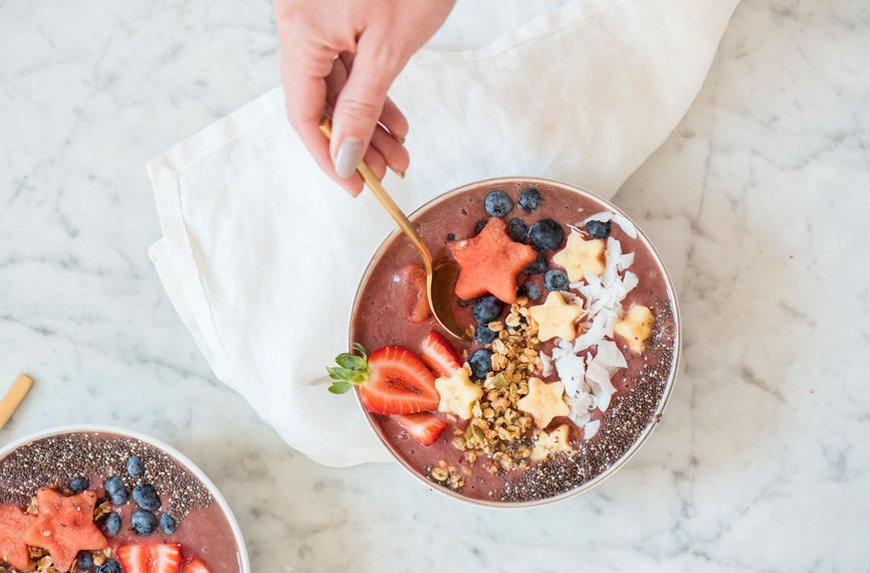But good looks and popularity aside, a wellness-crazed babe has to wonder: How do these almond-butter-drizzled, deep-hued wonders actually stack up nutritionally?
The short answer is it's complicated.“There is no one standard way to make an acai bowl, so they vary considerably," says sports dietitian Cynthia Sass, MPH, RD, CSSD. The one thing many of them do have in common is the acai itself, a fruit sourced from South American rainforests that, in and of itself, is quite healthy. It's packed with inflammation-fighting antioxidants and is super low in sugar when compared to other fruits, clocking in at just 2 to 3 grams of sugar per serving.
But since plain acai tastes bitter, that's not usually all you're getting. “It's not uncommon for bowls made with the whole fruit to be sweetened with artificial sugar and syrups, drizzled with honey on top, or blended with sweetened almond or soy milk,” says Sass. "And in addition to acai, most bowls contain other fruits, like banana and berries, and often nuts or nut butter, shredded coconut, or even chocolate.”
The other scenario is that many chains and local juice bars use “pomegranate powder” or “acai berry powder” instead of the whole fruit, both of which are pre-packed with added sugar. So you can see how the seemingly smart snack can pretty quickly turn into a sugar bomb, right?

{{post.sponsorText}}
Fortunately, like most healthy food trends (poke bowls, lattes, salads) there are ways to hack your acai bowl so it remains on the good-for-you end of the spectrum.
Keep reading for tips on building an acai bowl that's actually healthy.

Score some acai intel before you order
Don’t be afraid to do a little Q&A with the cashier before you order an acai bowl. You can ask whether they use fresh or powdered acai, and see if they'll let you take a peek at the nutrition label. "Look for one that’s got less than 10 grams of sugar [per serving] and some fiber,” suggests nutritionist Maggie Michalczyk, RDN, founder of Once Upon A Pumpkin. This is the same baseline you should use when you buy acai at the store.
Opt for a half-veg, half-fruit base
The bases of most acai bowls are made with more than just acai. Some, like Costco’s $5 bowl, are mixed with fresh blueberries and strawberries, while By Chloe’s bowl is all about the banana, almond milk, and berries. Sass recommends that you “minimize the total fruit in the bowl to one cup—including the acai.”
If you're ordering out, see if there's a menu option that includes equal parts fruit and veggies. And if you're making a bowl at home, you can get a little more creative. “Instead of just fruit, add in a generous portion of veggies, like finely chopped kale or shredded zucchini,” says Sass. Cauliflower—yep, the same stuff that upped the game for pizza crusts and oatmeal—is a bowl superstar as well. “It tastes pretty flavorless and makes your smoothie creamy,” says Michalczyk. She's also a fan of adding pumpkin puree to the blend, which gives the bowl a sweeter taste and an extra hit of fiber.
Top your bowl with fat and protein
If you’re making or ordering an acai bowl for breakfast, you want it to be brimming with protein and some fat—otherwise, you’ll be hungry again before like the ninth like. "Protein and fat have staying power, which means they'll keep you feeling full longer," says Michalczyk. "Who doesn't want to feel full from their breakfast?"
Her preferred forms of protein for acai bowls include collagen powder, hemp protein powder, chia seeds, and Greek yogurt. Once you've picked your protein, Sass says you should make sure there’s one added fat in the mix, like pumpkin seeds, a drizzle of almond butter, or a quarter of an avocado. “If you add in some protein and fat, you’ll have a bowl with nicely balanced macros, which results in a steadier blood sugar level and a better chance of using your bowl for energy," explains Sass.
So there you have it: Acai bowls can be part of a healthy breakfast, so long as you eat them the nutritionist-approved way. (And the low-sugar versions are just as 'grammable as the alternatives—promise.)
Oh hi! You look like someone who loves free workouts, discounts for cult-fave wellness brands, and exclusive Well+Good content. Sign up for Well+, our online community of wellness insiders, and unlock your rewards instantly.
Loading More Posts...